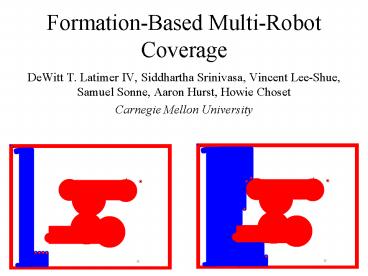FormationBased MultiRobot Coverage - PowerPoint PPT Presentation
1 / 20
Title:
FormationBased MultiRobot Coverage
Description:
Time-exposure photo of a coverage experiment. Characterize Critical Points ... (one corridor at a time) Lap. Wall follow. Critical Point Sensing. Look for anti ... – PowerPoint PPT presentation
Number of Views:42
Avg rating:3.0/5.0
Title: FormationBased MultiRobot Coverage
1
Formation-Based Multi-Robot Coverage
- DeWitt T. Latimer IV, Siddhartha Srinivasa,
Vincent Lee-Shue, Samuel Sonne, Aaron Hurst,
Howie Choset - Carnegie Mellon University
2
Coverage
- Determine a path that passes the robot (or
effector) over all points in a target region
(volume)
Random Probabilistic Complete Optimal
3
Problem Statement
- Assumptions
- Unknown space
- Homogenous circular robot
- No marking capability
- Common coordinate frame
- Task
- Complete coverage of space
- Coordinated among multiple robots
- Minimize repeat coverage
- Decentralized planning (yet coordinated)
4
Challenges
- Guaranteeing completeness
- Single robot Hert Lumelsky, Choset Acar, Cao
- Multi-robot Butler, Hollis, and Rizzi
- Minimize repeat coverage
- Planning in a multi-dimensional configuration
space - Balch and Arkin, each robot acts independently
- Space not known a priori
- Single robot Hert Lumelsky, Choset Acar, Cao
- Multi-robot Butler, Hollis, and Rizzi
- Scalability
5
Final (current) Demonstration
6
Cell-Decomposition Approach
- Define Decomposition
- Completeness
- Sensor-based Construction
- Incrementally construct
- Extend to Multiple Robots
7
Slice (Canny and Canny Lin)
h(x,y) x
8
Critical Point Sensing
slice
At a critical point x of
where M xm(x)0
9
Encountering All Critical Points
- Conventional back and forth motions are not
sufficient - (Cao et al.88, Hert et al.97, Lumelsky et
al.90)
10
Complete Coverage
- NOT Occupancy Grid Less memory, More meaningful,
Minimize turns, Completeness
11
Sensor-based Complete Coverage
Goal Complete coverage of an unknown
environment Cell decomposition Incremental
construction
Time-exposure photo of a coverage experiment
12
Characterize Critical Points
13
Cover Interior of Cell (one corridor at a time)
Wall follow
Lap
14
Critical Point Sensing
Look for parallel vectors during forward wall
following, but after a reverse wall follow,
lap, and then the forward
Look for anti-parallel vectors during reverse
wall following
Look for parallel vectors during forward wall
following
Look for parallel vectors during reverse wall
following
15
Action at Critical Points
Team divides into two separate teams, each
covering a new cell
VIRTUAL FRONTIER (Butler)
Team finishes cell and then looks for a new cell
to cover
16
Virtual Frontier
As an attempt to minimize repeat coverage, we use
the virtual frontier believing that another team
will be coming from the other cell associated
with the forward critical point
17
Team Rejoining (work in progress)
- Types of encounters
- Two teams covering in opposite slice directions
- Both teams finish the current corridor
- Two teams covering in same slice direction
- Both teams finish the current corridor
- One team covering and the other traversing
- Since robots only traverse through known space,
the covering team stops covering and joins
traversing team - Two teams encountering each other on the border
of two cells (very hard case) - Combine adjacency graphs
18
Example
19
Acknowledgements
- Dave Conner
- Ercan Acar
- Tucker Balch
- Matt Mason and Mike Erdmann
20
Distributed Localization and Mapping































